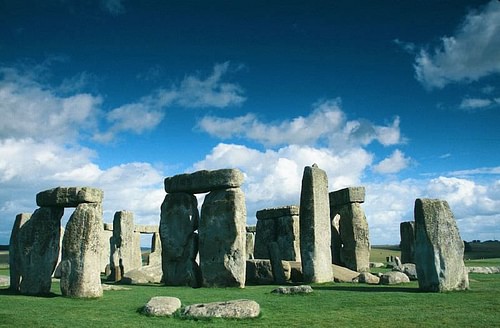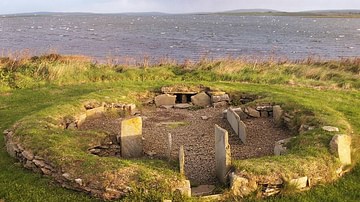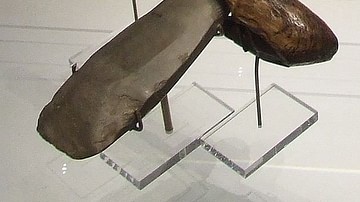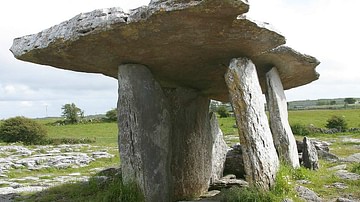
Stonehenge is a Neolithic / Bronze Age monument located on Salisbury Plain, Wiltshire, southern England. The first monument on the site, began around 3100 BCE, was a circular 'henge' earthwork about 360 feet (110 metres) in diameter, a 'henge' in the archaeological sense being a circular or oval-shaped flat area enclosed by a boundary earthwork.
This structure probably contained a ring of 56 wooden posts (or possibly an early bluestone circle), the pits for which are named Aubrey Holes (after the 17th century local antiquarian John Aubrey). Later, around 3000 BCE (the beginning of Stonehenge Phase II), some kind of timber structure seems to have been built within the enclosure, and Stonehenge functioned as a cremation cemetery, the earliest and largest so far discovered in Britain. Phase III at Stonehenge, beginning around 2,550 BCE, involved the refashioning of the simple earth and timber henge into a unique stone monument.
In the first stage, two concentric circles, (sometimes known as the 'Double Bluestone Circle'), of 80 'bluestone' (dolerite, rhyolite, and tuff) pillars were erected at the centre of the monument, with a main entrance to the North East. These bluestones, weighing about 4 tons each, originate in the Preseli Hills, in Pembrokeshire, south-west Wales, and were probably transported from there to Salisbury Plain over a route at least 185 miles long (see the chapter on Preseli). Apart from the bluestones, a 16.4-foot long greenish sandstone slab, now known as the Altar Stone, was brought to Stonehenge from somewhere between Kidwelly, near Milford Haven on the coast to the south of the Preseli Hills and Abergavenny, in southeast Wales.
It is thought that the northeastern entrance to the enclosure was remodelled during Phase III so that it precisely aligned with the midsummer sunrise and midwinter sunset of the period. Outside this entrance another feature, known as the Avenue, was added to the Stonehenge landscape. The Avenue (probably a ceremonial pathway) consists of a parallel pair of ditches and banks stretching for 1.5 miles from Stonehenge down to the River Avon. It had previously been thought that around 2,400 BCE the bluestones were dug up and replaced by enormous sarsen blocks brought from a quarry around 24 miles to the north on the Marlborough Downs.
However, recent work led by Mike Parker Pearson, Professor of Archaeology at the University of Sheffield has suggested redating the sarsen phase to 2640-2480 BCE, which would obviously affect the chronology of the site significantly. Thirty of these huge sarsens, each around 13.5 feet high, 7 feet wide, and weighing around 25 tons, were set up in a 98-foot diameter circle. On top of these were placed smaller sarsen lintels (horizontal stones) spanning the tops and held in place by 'mortice and tenon' joints. Within this sarsen circle a horseshoe-shaped setting of 15 more sarsens, making five trilithons (two large stones set upright to support a third on their top) was erected. Somewhere between 2280 and 1900 BCE, the blue stones were re-erected and arranged at least three times, finally forming an inner circle and horseshoe between the sarsen circle and the trilithons, mirroring the two arrangements of sarsen stones. This arrangement is essentially the monument that we see the remains of today.
Between 2030 and 1520 BCE a double ring of oblong pits, known as the Y and Z holes, were dug outside the outermost sarsen circle, possibly to take another setting of stones. However, there is no evidence that the holes ever held stones or wooden posts and they were eventually allowed to silt up naturally. The Y and Z holes seem to mark the end of significant activity at the site and after c. 1520 BCE there was no further construction at Stonehenge, and the monument appears to have been abandoned.
But why was Stonehenge built and was was it used for? As mentioned above, the monument certainly functioned as a cremation cemetery early in its history, probably for the burial of elite members of clans or prominent local families. The presence of a number of burials around Stonehenge which exhibit signs of trauma or deformity have suggested to some researchers, among them Professor Timothy Darvill of Bournemouth University, that the monument was a place of healing, akin to a prehistoric Lourdes. Other researchers, such as Professor Mike Parker Pearson, head of the Stonehenge Riverside Project at the University of Sheffield, believe that Stonehenge functioned as the domain of the dead in a ritual landscape that involved sacred processions to the nearby henge monument of Durrington Walls.
But it would be wrong to attempt to define a single use for Stonehenge. The function of the monument probably changed many times over its 1500-year history as different peoples came and went in the surrounding landscape, and the nature of society changed irrevocably from the Neolithic to the Bronze Age.







